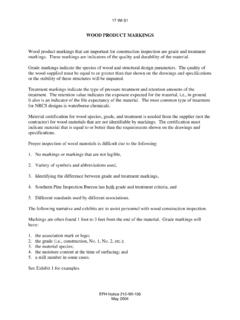Transcription of List of countries, territories and areas 1 Vaccination ...
1 List of countries, territories and areas1. Vaccination requirements and recommendations for international travellers, including yellow fever and malaria Introduction The information provided for each country includes the country's stated requirements and recommendations for travellers regarding yellow fever vaccination2 and malaria prevention; a brief description on the malaria risk situation is provided where appropriate. The country's stated requirements for other diseases are also mentioned, if any3. Country requirements are subject to change at any time. It is important that travellers ensure they know the requirements of the country to which they are travelling by checking with the relevant consulate or embassy. The latest updates received by WHO from countries can be found at: yellow fever Vaccination yellow fever Vaccination is carried out for two different purposes: 1.
2 To prevent the international spread of the disease Countries protect themselves from the risk of importing or further spreading the yellow fever virus by establishing entry requirements on yellow fever Vaccination for travellers. The countries that require proof of Vaccination are those where the disease may or may not occur and where the mosquito vector and potential non-human primate hosts of yellow fever are present. Any importation of the virus into such countries by infected travellers could result in its propagation and establishment, leading to a permanent risk of infection for the human population. Proof of Vaccination is often required for travellers arriving from countries with risk of yellow fever transmission and sometimes for travellers in transit through such countries.
3 A meeting of yellow fever experts proposed, in 2010, that under 12 hours of airport transit in an area at risk of yellow fever poses an almost non-existent risk of yellow fever and therefore that a proof of Vaccination might not be necessary. This information is provided to WHO Member States, but travellers are recommended to consult individual country requirements by contacting the embassy of each country they intend to visit. It should be noted that some countries require proof of Vaccination from all travellers. Countries requiring yellow fever Vaccination for entry do so in accordance with the International Health Regulations. yellow fever is currently the only disease for which proof of Vaccination may be required for travellers as a condition of entry to a State Party under Annex 7 of the International Health Regulations (IHR).
4 An important change in May 2014 was the adoption by the World Health Assembly of an updated Annex 7, extending the validity of a certificate of Vaccination against yellow fever from 10 years to life; this will come into force from 11th July 2016. The fact that a country has no requirement for yellow fever Vaccination does not imply that there is no risk of yellow fever transmission. 1 In this publication, the terms country and countries cover countries, territories and areas . 2 WHO publishes these requirements for informational purposes only; this publication does not constitute an endorsement or confirmation that such requirements are in accordance with the provisions of the International Health Regulations. 3 The requirements for Vaccination of infants over 6 months of age by some countries are not in accordance with WHO's advice (Chapter 6).
5 Travellers should, however, be informed that the requirement exists for entry into the countries concerned. When available, the date of the most recent update or confirmation is indicated in parentheses in the country list. If no date is indicated, the most recent update or confirmation was provided before 2013. 2. To protect individual travellers who may be exposed to yellow fever infection The risk of yellow fever transmission depends on the presence of the virus in the country in humans, mosquitoes or animals. As yellow fever is frequently fatal for those who have not been vaccinated, Vaccination is recommended for all travellers (with few exceptions, Chapter 6) visiting areas where there is a risk of yellow fever transmission. Annex 1 in the International Travel and Health publication provides a summary list of countries with risk of yellow fever transmission in whole or in part as defined by WHO as well as a list of countries that require proof of yellow fever Vaccination as a condition for entry.
6 WHO determines those areas where a risk of yellow fever transmission is present on the basis of the diagnosis of cases of yellow fever in humans and/or animals, the results of yellow fever sero-surveys and the presence of vectors and animal reservoirs. The scientific and technical advisory group on geographical yellow fever risk mapping (GRYF) was established in 2015 to maintain up-to-date yellow fever risk mapping and to provide guidance on yellow fever Vaccination for travellers in ways that facilitate international travel, see further information from Decisions regarding the use of yellow fever vaccine for travellers must weigh several factors, including the risk of travel-associated yellow fever virus disease, country requirements, and the potential for serious adverse events following yellow fever Vaccination (Chapter 6).
7 The table below summarizes WHO's revised recommendations for yellow fever Vaccination for travellers. yellow fever Vaccination category Rationale for recommendation Recommended yellow fever Vaccination is recommended for all travellers 9 months old in areas where there is evidence of persistent or periodic yellow fever virus transmission. Generally not recommended yellow fever Vaccination is generally not recommended in areas where there is low potential for yellow fever virus exposure (no human yellow fever cases ever reported and evidence to suggest only low levels of yellow fever virus transmission in the past). However, Vaccination might be considered for a small subset of travellers to these areas who are at increased risk of exposure to mosquitoes or unable to avoid mosquito bites.
8 When considering Vaccination , any traveller must take into account the risk of being infected with yellow fever virus, country entry requirements, as well as individual risk factors ( age, immune status) for serious vaccine-associated adverse events. Polio On 5 May 2014 the Director-General declared the international spread of wild poliovirus in 2014 to be a public health emergency of international concern (PHEIC) under the International Health Regulations, and issued temporary recommendations to reduce the international spread of wild poliovirus. Recommendations concerning international travellers coming from affected countries are below. For States currently exporting wild poliovirus (WPV) or circulating vaccine-derived poliovirus (cVDPV), it is recommended that: All residents and long-term visitors ( > 4 weeks) of all ages receive a dose of oral poliovirus vaccine (OPV) or inactivated poliovirus vaccine (IPV) between 4 weeks and 12 months prior to international travel.
9 International travellers undertaking urgent travel ( within 4 weeks) who have not received a dose of OPV. or IPV in the previous 4 weeks to 12 months, receive a dose of polio vaccine at least by the time of departure;. this will still provide benefit, particularly for frequent travellers. Travellers are provided with an international certificate of Vaccination or prophylaxis in the form specified in Annex 6 of the IHR, to record their polio Vaccination and serve as proof of Vaccination . The international travel of any resident lacking documentation of appropriate polio Vaccination is restricted at the point of departure. This applies to international travellers from all points of departure, irrespective of means of conveyance ( road, air, sea).
10 For States affected by WPV or cVDPV but not currently exporting, it is recommended that: Residents and long-term visitors receive a dose of OPV or IPV 4 weeks to 12 months prior to international travel, or, for those undertaking urgent travel ( within 4 weeks), a dose at least by the time of departure. Travellers who receive such Vaccination have access to an appropriate document to record their polio Vaccination status. Updates on currently endemic and affected States, whether exporting the disease or not, can be found at: ( key countries page). Some individual polio-free countries also require proof of polio Vaccination for a visa or entry into their territory. It is important that travellers ensure they know the requirements of the country to which they are travelling by checking with the relevant consulate.















